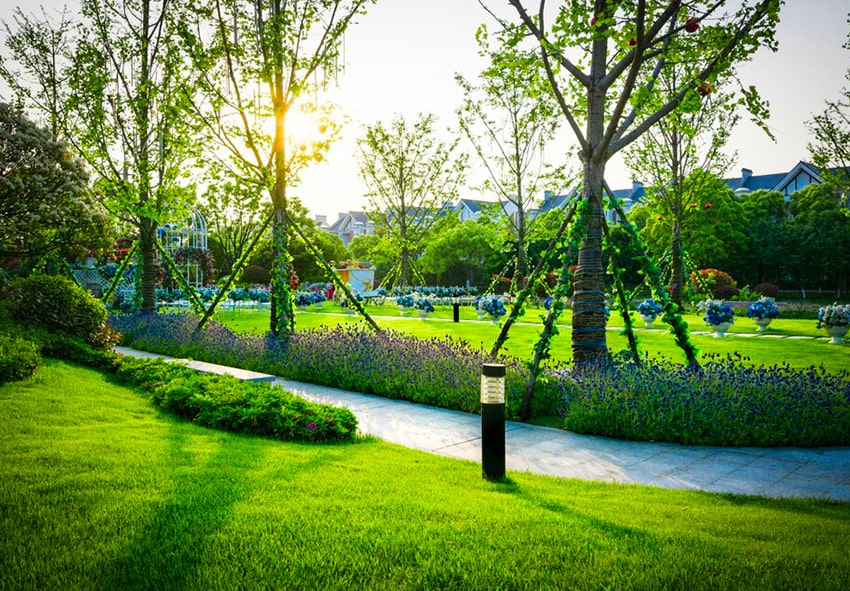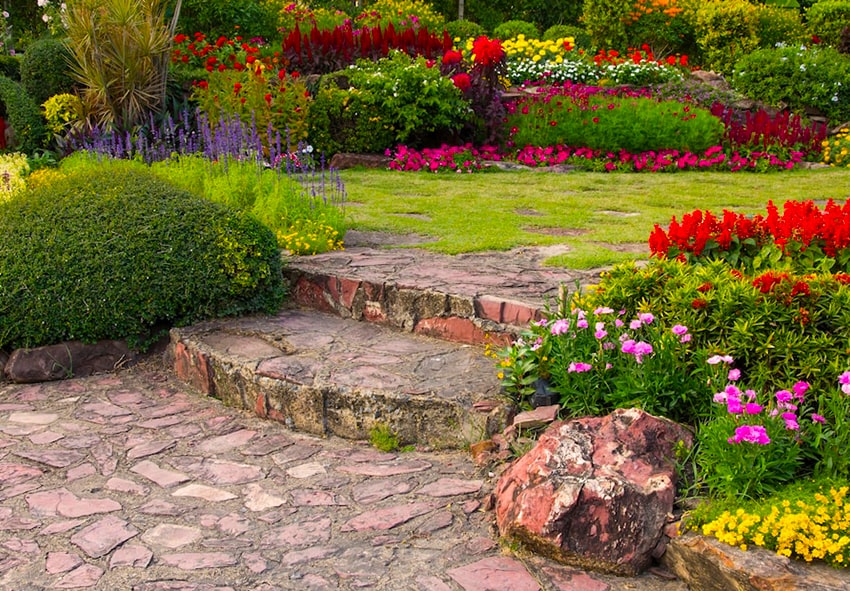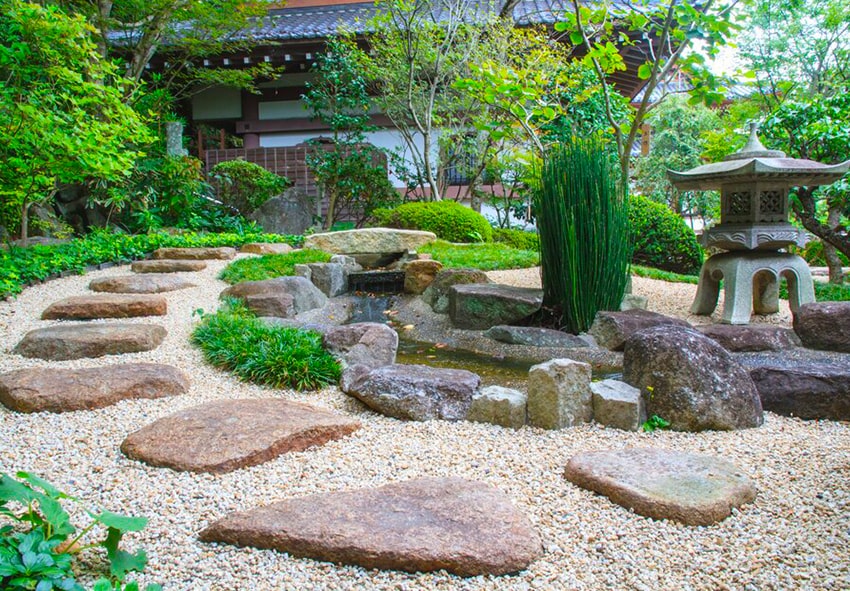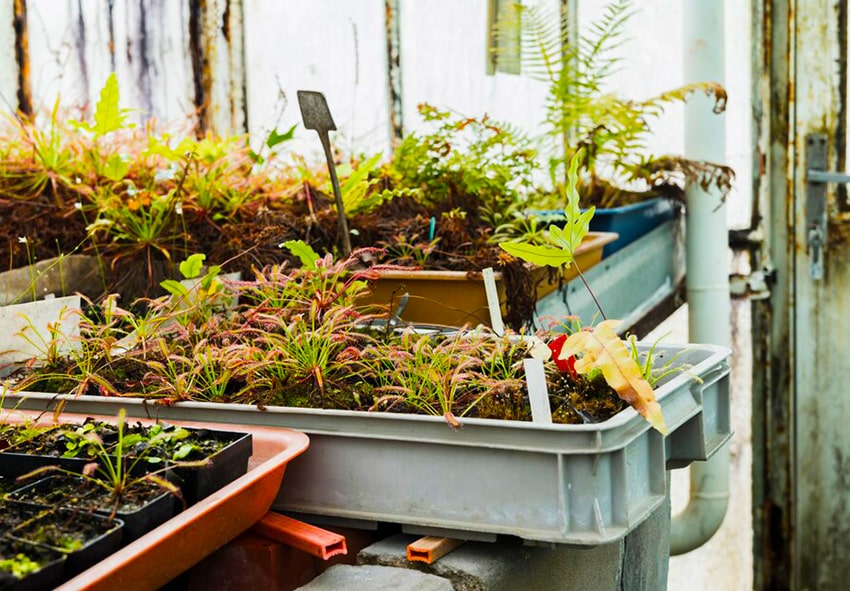Soft landscaping is the art of designing and creating a garden with plants, flowers, and other natural elements. Soft landscaping can transform your outdoor space into a relaxing and inviting oasis that reflects your personality and style. Soft landscaping can also enhance the value and curb appeal of your home by adding color, texture, and fragrance to your landscape.
These procedures will enable you to design a lovely garden that satisfies your requirements, preferences, and constraints. Soft landscaping has several advantages, including improved health, enjoyment, and environmental preservation.
Planning Your Soft Landscaping

Before you start digging and planting, you need to plan and design your soft landscaping. Planning your soft landscaping involves identifying your needs, wants, and limitations, and creating a design that complements your home and lifestyle.
The first step in planning your soft landscaping is to identify your needs, wants, and limitations. These are the factors that will influence your choices and decisions throughout your project.
Making a design that is complementary to your house and way of life is the next stage in arranging your soft landscaping. A design is a depiction in visual form of the way you want your garden to appear and work. You can express your goal, organize your thoughts, and direct your implementation with the aid of a design.
You should take into account the following elements to produce a design that blends with your house and way of life:
- Scale: the dimensions and relationship of your garden to your house and the area around it.
- Shape: how your garden’s shape and outline relate to the existing elements and buildings
- Color: how intensely colored the plants and other elements are in proportion to one another and the seasons.
- Texture: How the plants and characteristics seem on the outside in relation to one another and the senses.
- Harmony: the agreement and compatibility of the plants and features in relation to each other and the overall theme. Line: the direction and movement of the plants and features in relation to each other and to the eye. Balance: the distribution of weight and interest.
- Contrast: The variety and differences among the plants’ characteristics in regard to one another and the object of attention
- Rhythm: the recurrence and variation of the plants and characteristics with respect to one another and the flow.
- Focal point: the focal point and center of interest for the spectator and the plants in relation to one another.
You may make a design that is visually beautiful, practical, and unique by taking these factors into account.
You must pick the appropriate plants and garden accents once you have planned and constructed your soft landscaping. The components that make up your soft landscaping are plants and accents. They consist of plants like trees, bushes, flowers, walkways, and sitting spots, among others.
Consider their appropriateness, compatibility, and availability while selecting the proper plants and garden accents. Additionally, think about their advantages, expenses, and upkeep.
Plant Selection
The process of selecting plants that are appropriate for your climate, soil type, and sunshine exposure is known as plant selection. Plant selection also includes selecting plants that complement one another as well as your garden’s design and theme.
Select plants that are native to your area or have adapted to it. They will thrive in your climate and soil conditions more probable. They will also be less susceptible to pests and illnesses.
Select plants that will thrive in the amount of sunshine you have. Some plants like full sun (at least six hours per day), others prefer partial light (four to six hours per day), yet others prefer partial shade (two to four hours per day), and still others prefer full shadow (less than two hours per day).
Select plants that compliment one another. Some plants have colors, forms, or textures that are similar or opposing, creating a harmonious or dramatic impression. Some plants have mutually beneficial or negative connections that impact their development or health.
Plants that are well-balanced and harmonious in their plant palette should be chosen. A plant palette is a grouping of plants that complement each other in terms of color, shape, texture, bloom period, aroma, and so on. A plant palette should include a range of plants to add interest and diversity, but not too many to cause confusion and disorder.
Garden Features
Garden features are the elements that add functionality and visual interest to your garden. They include paths, water features, seating areas, etc.
Choose features that complement your plants and garden style. Some features have similar or contrasting colors, shapes, or textures that create a harmonious or dramatic effect. Some features have beneficial or detrimental relationships with your plants that affect their growth or health.
Choose features that enhance your garden function and experience. Some features provide practical functions such as access, drainage, or storage. Some features provide sensory functions such as sound, sight, smell, or touch.
Choose features that create focal points and interest in your garden. Some features draw attention and attraction to a specific area or element in your garden. Some features create surprise and curiosity in your garden.
Soft landscaping Techniques

Use the best planting, mulching, and maintenance techniques after selecting the appropriate plants and garden components. Making and maintaining garden beds, borders, and containers is one of these techniques.
Preparing and organizing your plants and garden features involves making garden beds, borders, and containers. The location, size, shape, and design of garden beds, borders, and containers must all be taken into account.
Follow these steps to make garden beds, borders, and containers:
- Use stakes, strings, or spray paint to mark the location and outline of your garden beds, borders, and containers. Ensure that they match your design and available space.
- Remove any grass, weeds, rocks, or other objects from the area. Any existing plants or features that you don’t want to keep can be dug up or eliminated.
- Construct or position your surrounding borders or containers. You can make use of a variety of materials, including wood, stone, brick, metal, and plastic. Make certain that they are level and strong.
- Add topsoil, compost, and other amendments to the area. Either your own soil or a ready-made mix can be used. Make sure the soil is free-draining and loose.
- Place your flowers where you’ve planned and spaced them out. You can employ a variety of methods, including seed sowing, raised beds, and container gardening. Ensure that the plants are strong and rooted.
- After planting, give your plants a good soak to help the soil settle and flush out air bubbles. You can water by hand, with sprinklers, or with drip irrigation, among other techniques. Ensure that the water reaches the plants’ root zone.
Planting Techniques
Planting techniques can vary based on the type of plants you want to grow, the available space, and your personal preferences. Here are some popular planting techniques and tips for caring for different types of plants:
- Container Gardening
Container gardening is a popular planting technique for people who have limited space or want to grow plants indoors. It involves planting in pots, buckets, or other containers that can hold soil and drain water. Make sure the container is the right size for the plant you want to grow and has good drainage. Use high-quality potting soil that provides good drainage and nutrients. Container plants need to be watered more frequently than plants grown in the ground. Make sure the soil is moist but not waterlogged. Container plants need regular fertilization to thrive. Use a balanced fertilizer according to the instructions on the package.
- Raised Beds
Raised beds are another popular planting technique that involves building a bed with soil raised above the surrounding ground level. Raised beds can be made of wood, concrete blocks, or other materials. Make sure the raised bed is located in a spot that gets plenty of sun and has good drainage. Raised bed soil should be rich and fertile. Mix in compost and other organic matter before planting. Raised beds need to be watered deeply to encourage deep root growth. Water at the base of the plants, not on the leaves. Mulching helps retain moisture in the soil and suppress weeds.
- Seed Sowing
Seed sowing involves planting seeds directly in the ground or in containers. Make sure the soil is loose and fertile before planting seeds. Different plants have different seed sowing requirements. Follow the instructions on the seed packet for best results. Seeds need to be kept moist for best germination. Water gently to avoid disturbing the seeds. Once the seeds have germinated, thin out the seedlings to provide enough space for the plants to grow.
- Spacing and Arranging Plants
Spacing and arranging plants is an important consideration when planting. Make sure you space plants according to their mature size, not their current size. Arrange plants in groups or clusters for maximum visual impact. Make sure plants have enough space to grow and spread without crowding each other. Consider the height of each plant when arranging them. Taller plants should be placed in the back and shorter plants in the front.
Mulching and Soil Amendments
You should carry out the following actions while using mulch and other soil additives in your garden.
For your plants and soil, pick the proper kind and quantity of mulch and soil additives. Compost, manure, leaves, grass clippings, straw, wood chips, bark, pine needles, gravel, stone, pebbles, plastic, cloth, etc. are just a few examples of the things you can utilize.
Cover your plants with a 2 to 4 inch layer of mulch and soil amendments. To avoid rotting or disease, give your plants some room around the base. Although you can add mulch and soil amendments at any time of the year, spring and fall are the finest.
Over the course of the season, replenish your mulch and soil amendments as necessary. As your mulch and soil amendments deteriorate or wash away, replenish or replace them. Mulch and soil amendments should not be disturbed or mixed with the soil.
You should also take into account the following recommendations while selecting organic soil additives and mulches that are appropriate for your region’s climate. Over time, they will decay and release nutrients into your soil. Additionally, they will draw beneficial insects and microbes to your soil. Select inorganic soil additives and mulches that are appropriate for your plants and garden design. Over time, they won’t break down or release nutrients into your soil. They will also stop soil erosion and weed growth. Select slow-release fertilizers that are appropriate for the type of soil and plants you have. Over time, they will gradually release nutrients. They will also stop you from fertilizing your plants too much or too little.
Soft Landscaping Styles and Themes

After you have applied the best techniques for planting, mulching, and maintaining your soft landscaping, you can explore different soft landscaping styles and themes. Soft landscaping styles and themes are the ways of expressing your personality and taste through your garden. They include cottage gardens, formal gardens, zen gardens, etc.
Exploring different soft landscaping styles and themes involves considering their characteristics, advantages, and disadvantages. You should also consider their suitability for your home and lifestyle.
Cottage Gardens
Soft landscaping trends like cottage gardens have their roots in 18th-century England. The casual, homey, and pleasant aspect of cottage gardens defines them. Colorful, fragrant, and tasty plants are abundant in cottage gardens. Rustic, whimsical, and practical aspects are also present in cottage gardens.
In addition to providing fresh flowers, herbs, fruits, and veggies for your house, they are simple to establish and maintain with few resources. They also draw birds, butterflies, bees, and other animals to your garden.
To make a cottage garden you should pick a sunny, well-drained area for your cottage garden. You can utilize a space of any size or shape, but a curved or uneven outline will give it a more relaxed and natural appearance. For your cottage garden, use plants that are suited to the soil and temperature where you live. A wide range of flora, including roses, lavender, hollyhocks, foxgloves, daisies, poppies, etc., can be used. You can also utilize fruits, vegetables, and herbs like mint, thyme, sage, strawberries, and raspberries. Pick elements that go well with your rustic garden. Fencing, gates, arbors, trellises, birdhouses, birdbaths, benches, and other useful as well as whimsical design elements are acceptable. Additionally, you can utilize recycled or repurposed materials like used barrels, buckets, and pots. For your cottage garden, distribute your plants randomly and densely. You can combine various plant species to make a vibrant and fragrant arrangement. Additionally, you can stack your plants, going from tall to short, to add depth and interest. Water, fertilize, prune, and deadhead your cottage garden on a regular basis. To preserve moisture and control weeds, you can also mulch your garden with organic materials. Additionally, you can modify your garden by removing or substituting any plants that are not flourishing or that seem out of place.
Formal Gardens
In the 17th century, formal gardens, a type of soft landscaping, were first developed in France. Symmetrical, geometric, and refined are the characteristics of formal gardens. In formal gardens, there are only a few carefully chosen and arranged plants. Additionally, formal gardens have elaborate, refined, and sophisticated features.
They create a magnificent backdrop for your home and activities and give your garden structure and harmony. Additionally, they accurately and clearly represent your plants and other attractions. They need minimal work and upkeep.
To create a formal garden, you ought to take the following steps:
- Select a location that is flat and well-drained for your formal garden. Any space can be used, but a rectangle or square perimeter will make it appear more symmetrical and geometric.
- Choose plants for your formal garden that will flourish in the local soil and climate. Only a small number of plants, including topiary, boxwood, yew, and hedges, are allowed. Use blooms with a recurring or distinctive color, shape, or texture, such as roses, lilies, or tulips.
- Select decorative elements that go well with your formal landscape. Useful decorative elements include fountains, statues, urns, columns, and other elegant, elaborate, and sophisticated elements. Objects with geometric or symmetrical shapes, such circles, squares, triangles, etc., can also be used as design elements.
- To create a formal garden, place your flowers in a regular, organized pattern. Plants can be arranged in straight lines, grids, patterns, or forms to provide a symmetrical and geometric presentation. Additionally, to get a consistent and attractive appearance, trim your plants into orderly shapes.
- Regularly water, fertilize, prune, and edge your formal garden to keep it looking good. To preserve moisture and keep weeds from growing, you can also mulch your garden using inorganic materials. Additionally, you may modify your garden by removing or adding new plants to any areas that have broken or misplaced elements.
Zen Garden
Zen gardens are soft landscaping designs that date back to the 14th century in Japan. Zen gardens have an understated, peaceful, and meditative aspect. A few plants that are symbolic and significant may be found in zen gardens. Simple, organic, and expressive aspects can also be found in zen gardens.
Some of the benefits of zen gardens are:
- They create a sense of calm and peace in your garden
- They stimulate your senses and imagination with subtle and suggestive elements
- They provide a space for reflection and contemplation in your home
- They are easy to create and maintain with minimal resources
For your zen garden, pick a spot that is remote and well-drained. Any size or form of space can be used, but a compact and private outline will provide a more understated and calm appearance.
For your zen garden, use plants that are suited to the soil and temperature where you live. Several plants, including moss, ferns, bamboo, etc., can be used. You may also utilize flora like pine, maple, cherry, etc. that are symbolic or important.
Pick elements that are appropriate for your zen garden. You may utilize elements like rocks, sand, gravel, water, etc. that are plain, organic, and expressive. Additionally, you may make advantage of architectural elements with symbolic or deep meaning, such bridges, lanterns, pagodas, etc.
For your zen garden, place your plants sparingly and unevenly. To create a focal point or a contrast, you might strategically put your plants. To provide an impression of space and nothingness, you may also leave certain places unfilled or cover them with gravel or sand.
Water, fertilize, prune, and rake your zen garden on a regular basis. Organic materials may be used as mulch in your garden to retain moisture and control weed growth. Additionally, you may alter your garden by getting rid of or changing any plants or elements that are unsuitable or distracting.
Maintaining Your Soft Landscaping
Soft landscaping maintenance involves caring for the non-structural elements of a landscape, such as plants, grass, and trees. Here are some best practices for maintaining your soft landscaping:
Prune your plants regularly to promote healthy growth and remove any dead or diseased wood. Use sharp, clean pruning shears, and make clean cuts to avoid tearing the bark. Some plants, like roses, require specific pruning techniques, so be sure to research the best method for your plants.
Deadheading is the process of removing spent flowers from plants to encourage more blooms. This helps keep your plants looking tidy and prolongs the flowering season.
Some plants, like tomatoes and tall flowers, need to be staked to prevent them from falling over. Use a sturdy stake and tie the plant to it with a soft material like twine or garden tape.
Preventing and addressing common soft landscaping problems:
Prevent pests by keeping your plants healthy and well-maintained. Remove any dead or diseased wood, and avoid overcrowding your plants. If you do have a pest problem, try using natural remedies like neem oil or insecticidal soap before resorting to chemical pesticides.
Prevent diseases by providing your plants with good air circulation and avoiding overhead watering. Remove any infected plants or leaves immediately to prevent the spread of disease. If necessary, use a fungicide to treat the affected plants.
In summary, maintaining soft landscaping involves regular watering, fertilizing, and pruning. Additionally, tasks like deadheading and staking can help promote healthy growth. Preventing and addressing common problems like pests and diseases involves keeping your plants healthy and using natural remedies whenever possible.
Watering and Fertilizing

Providing your plants with water and nutrients for optimum development and health are the procedures of watering and fertilization. Choosing the proper sort and quantity of water and fertilizer for your plants and soil is a crucial part of watering and fertilizing.
In order to properly water and fertilize your plants, you should:
- Select the proper type and quantity of fertilizer and water for your soil and plants. Water and fertilizer can be used in a variety of ways, including tap water, well water, rainfall, etc. Additional fertilizer options include organic, inorganic, slow-release, liquid, granular, etc.
- Comply with the directions on the label or packaging for the water and fertilizer. According to your plants’ requirements and preferences, you should water and fertilize them. In accordance with the time of year and the climate, you should water and fertilize your plants.
- For your plants and soil, provide water and fertilizer at the proper time and frequency. When the top 1 to 2 inches of soil feel dry to the touch, water your plants. Throughout the growth season, you should fertilize your plants at regular intervals.
- Deeply and thoroughly water your plants until water drains from the bottom of the container or bed. To limit evaporation and avoid leaf burn, water your plants in the early morning or late at night. It’s best not to water your plants too often or too seldom.
- Try not to overwater and fertilize your plants. Problems like root rot, nutrient burn, salt accumulation, fungal infection, etc. can result from overwatering and fertilization.
Pruning and Deadheading
To enhance your plants’ health and look, prune and deadhead them to remove any undesirable or damaged sections. Choosing the proper kind and quantity of trimming and deadheading for your plants is a part of pruning and deadheading.
Pick the appropriate pruning and deadheading technique and frequency for your plants. Pruning and deadheading techniques include thinning, shaping, renewing, and more. As well as using different tools like scissors, shears, and saws, you may also prune and deadhead your plants.
Observe the pruning and deadheading manual or guide recommendations. Your plants’ requirements and preferences should be considered while pruning and deadheading them. Additionally, depending on the season and development stage, you should trim and deadhead your plants.
Prune and deadhead your plants at the right time and frequency for your plants. You should prune your plants when they are dormant or before they start growing in spring or fall. You should deadhead your plants when they finish blooming or when they start fading or wilting.
Prune and deadhead your plants carefully and cleanly to avoid damaging them. You should cut your plants at an angle just above a bud or a branch. You should avoid cutting your plants too much or too little.
Avoid common pruning and deadheading mistakes. Some common mistakes include pruning or deadheading at the wrong time or frequency, pruning or deadheading too much or too little, pruning or deadheading with dull or dirty tools, pruning or deadheading without a plan or a purpose, etc.
Frequently Asked Questions (FAQs) about Soft Landscaping
1. What is Soft Landscaping, and how does it differ from Hard Landscaping?
Soft landscaping focuses on the living elements of your outdoor space, such as plants, trees, shrubs, and flowers. It involves creating lush greenery, colorful blooms, and a natural ambiance in your garden or outdoor area. In contrast, hard landscaping includes hardscape elements like paths, patios, walls, and structures. Soft landscaping adds life and vibrancy to your garden, while hard landscaping provides structure and functionality.
2. What are some popular soft landscaping ideas for a small backyard?
For small backyards, consider using vertical gardening with climbing plants to maximize space. Opt for low-maintenance plants like succulents or native species to reduce upkeep. Create a focal point with a striking tree or a colorful flower bed. Incorporate hanging baskets, potted plants, or window boxes to add greenery without using up valuable ground space.
3. How can I choose the right Netherlands plants for my soft landscaping project?
Select plants that thrive in your local climate and soil conditions. Consider factors like sunlight, water requirements, and growth habits. Mixing evergreen and deciduous plants can provide year-round interest. Additionally, think about the color palette and aesthetics you want to achieve, and choose plants that complement your vision.
4. Can I order soft landscaping plants from your online store?
At our online store, you can find a wide selection of soft landscaping plants, including trees, shrubs, perennials, and more. We offer a convenient and hassle-free way to purchase and have these plants delivered to your doorstep. Our website provides detailed information about each plant’s care requirements, ensuring you make the right choices for your soft landscaping project.
5. What are some soft landscaping ideas for enhancing curb appeal?
To boost curb appeal, consider planting a welcoming front garden with a mix of colorful flowers and evergreen shrubs. Create a well-defined path to your entrance using decorative paving stones or gravel. Incorporate symmetry and balance in your planting design for an inviting look. Accentuate the softscape with outdoor lighting to make your home’s exterior more appealing during the evening hours.
Published: 03.05.2023
